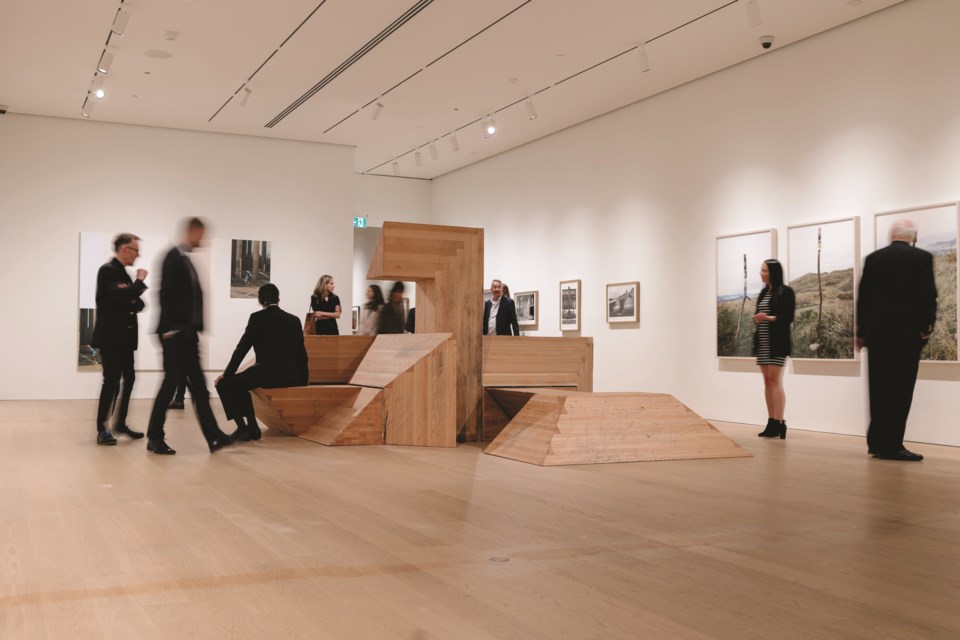Three, 3,000-kilogram marble barriers sit in the middle of a room at the Audain Art Museum.
There were actually five pieces, created by artist Cameron Kerr, in a private collector’s house on Bowen Island. Only, it turns out there are a whole host of logistical hurdles to jump in order to transport art that weighs as much as a small elephant—elevator, truck, and floor capacity chief among them.
“Three thousand kilograms is the limit of our forklift to lift things, and the big [sculpture] actually weighs more than 3,000 kg,” says Kiriko Watanabe, curator at the museum, who was tasked with monitoring that transport closely.
It might have been a unique problem, but it’s fitting for a unique exhibit. The sculptures are just one part of Out of Control: The Concrete Art of Skateboarding, which runs at the museum until Jan. 8.
“The show is very much what the title says,” says guest curator Patrik Andersson, an associate professor with Emily Carr University who teaches contemporary art.
“It’s about who’s in control. What does it mean to be out of control? The subtitle—the concrete art of skateboarding—is relating the relationship between art and architecture. I’ve designed the show almost like a concrete poem.”
While the exhibit marries skateboard culture and visual art, the show could certainly help the museum with its goal to bring more young patrons through the door.
“I see skateboarders hanging out, outside the museum on our staircase on their way or after they skated at the skate park. I’d love to say, ‘Come in,’ but then I realized, ‘OK, would they be interested in seeing what we have?’ Really, I wanted them to get excited about art,” Watanabe says.
To that end, Andersson created several distinct sections to the exhibit—including one exhibit-within-an-exhibit tucked into a closet off the first room, curated by Michelle Pezel, who owns Vancouver’s Antisocial Skateboard Shop.
“It was nice of the museum to allow me to use this space,” Andersson says of the long, narrow closet usually hidden away. “[Pezel] has always had a gallery in her store and the gallery is in a closet in the back of her store. When I showed this to her she was like, ‘Oh yeah.’”
Other sections include: Rethinking the Barriers of Public Space, addressing the “designed environment” that skateboarders face; House, Home, and Freedom to Move, which features a fabric house created by Mikaela Kautzky made from bedsheets, table cloths and other items from her childhood home with a film screening inside; Language, Poetry, Music and Youth Culture, playing Dan Graham’s documentary Rock My Religion; Finding Balance in Art, Life, and Skateboarding, including a photo series by Samuel Roy-Bois created for the exhibit called Black Mountain, a play on the drinking game Wisest Wizard; and Skateboarding on the Edges of Modern Art, which includes Raphaël Zarka’s “Paving Space—Regular Score, W9M1,” produced by Squamish’s Van Urban Timber. Days before that piece was installed, skateboarders actually skated it, creating rough, splintered edges and marks on what was a pristine sculpture.
Upstairs, meanwhile, features five artists who respond to tropes of skateboarding’s rebellious side.
While the show features local, national and international artists, the majority are from B.C.—and a surprising number wanted to create new pieces for it.
“Patrik and I started working on this show more than three years ago and the majority of the artists featured in this exhibition are, or once were, skateboarders, so they got so excited,” Watanabe says. “Because the exhibition date was so far in advance, they wanted to create new works for this exhibition. The museum was happy to have supported some of the major productions such as Raphaël Zarka’s sculptures that we marked in Whistler and had people skate on prior to the installation, as well as Andrew Dadson’s new series of cuneiforms that are being shown for the first time. Many of those new prints of cuneiforms were taken in Vancouver in the last few months. We were very happy to have supported that creation.”
Filled with wildly varying mediums, interactive pieces, and a general youthful exuberance, the show breaks new ground for the museum.
“I hope that people will agree that this exhibition that Patrik curated engaged not only youth, but also serious art-gallery goers,” Watanabe says. “Because it really shows you how visual arts and sport can go together.”


.jpg;w=120;h=80;mode=crop)

